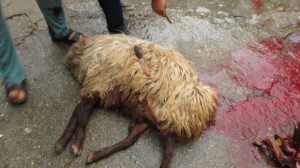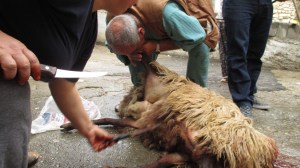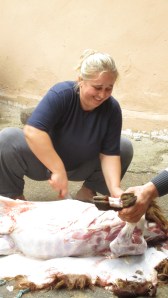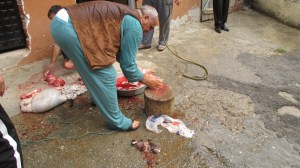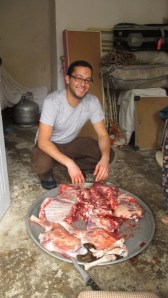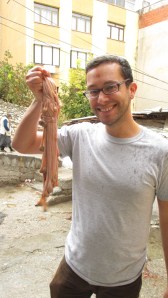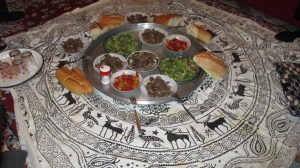I was lucky enough to talk about my research with Michael Mackenzie, on his show RN First Bite, from the Australian Broadcasting Corporation. Go give it a listen here.
Tag Archives: Meat
Killing an Animal
We picked up Zeynep, her husband, and their son from the Turan Metro station, just past the Karşıyaka bridge, where the road turns sharply eastward towards Alsancak and the other side of the İzmir Bay.
Zeynep’s mom and dad live in Gültepe, which is east of Konak. (We previously met Turgut Bey at the hayvan pazarı) It’s before the Çevre Yolu (the perimeter freeway). The Çevre Yolu is almost exactly like I-580 in Oakland, but a more remote version. Gültepe means Rose Summit, but it was pretty much all Tepe and no Gül. A rainy night in a rental car with five people navigating steep hills is a stressful way to enter into an animal sacrifice situation.
We drove up, up, up Gültepe until we came to a street dead-ended by a staircase. The rain was steady at this time, and there were thunder rumblings.
The house was filled with aunts, uncles, and kids. One of the kids fetched a rock to place under my car tire, as the hill was dangerously steep.
Mary and I met everyone, put on our guest slippers, got our customary handful of limon kolonya, and went into the living room to drink tea and eat baklava. After 30 minutes of chit chat, it was time to initiate sacrifice sequence! Turgut Bey went into a small bedroom to pray, and then we went outside.
The sheep looked the same since I had seen him last week. He wasn’t panicked or twitchy, just calm and slightly stubborn in the way that sheep are. I started to tell him “hey buddy, it’s gonna be okay,” but cripes, he was walking the Green Mile.
My sheep had been living here for two days, in a tool shed with its own drain. Turgut Bey made sure to point out the drainage, lest I think that they were allowing the blood to run into the street.
Turgut Bey put on his butchery outfit; green pajamas with a leather vest. Looks like he stole my Halloween costume idea: Muslim Power Ranger.
Turgut Bey picked up the sheep and gently placed it on its side. Then he tied three of the legs together. Everyone gathered around to watch. I felt clumsy as I tried to hold my notebook and my camera while trying to help hold the sheep down. It was kind of like when you’re trying to give an animal a pill; you need to find that sweet spot of firm, yet compassionate force. Any excess wrangling or roughing up would be considered an “eziyet” (mistreatment) to the kurban, and my thought process was along the lines of “don’tfuckthisupdon’tfuckthisupdon’tfuckthisup.”
I had not participated in the namaz (prayer) before the sacrifice, nor was I planning on participating in the two prayers required after the sacrifice, so Turgut Bey was to kill the sheep. Since it was my purchase, the sheep was technically mine to kill. I had to formally give my vekalet (agency/representation) over to Turgut Bey so that he could perform the sacrifice. He asked me three times for my vekalet, same question each time, and then it was time to cut. The repetition reestablished the emphasis on agency transfer, and made me feel like some execution-happy Texas governor.
The knife, albeit a bit dull, had been blessed, so we couldn’t use the razor-sharp 7” boning knife I had brought along. (Helal butchery dictates the blade must be sharp, but the defintion of “sharp” is, like most religious decrees, subjective). The blade was inscribed with “Bismillah ir-rahman ir-rahim” in Arabic, meaning “The name of Allah, most gracious, most compassionate.”
Turgut Bey took the knife and placed it flat-side against the sheep’s throat. The sheep looked on plainly, definitely a bit uncomfortable, but used to being handled by people. Then the knife was dragged back and forth as if shaving the sheep’s neck, in order to smooth out the wool and locate the cut site. I was holding the sheep down tightly with Zeynep’s son and brother. Turgut Bey said “Bismillah!” and sliced the sheep. It took a few hard, directed cuts to get through the jugular and carotid, and Turgut Bey was sprayed by a meter-high blood spurt. The sheep didn’t have time to bleat, but there was a gurgling croak just as I saw the occipital condyles appear. I saw the spinal arteries, which was when Turgut Bey briefly paused to mention that those were the “can damarlari” (life veins). Technically speaking he’d cut the life veins, but as soon as the vertebral arteries were cut, the animal was, how to put it, “more dead.”
Everyone observing was calm, but not nervous or bummed out. This is a festive holiday, after all, but tinged with the solemn fact of death, of transforming a life into meat. Once the head was removed, the knife was carefully placed on top of the still-convulsing sheep’s body. The head stared at me calmly, and I saw the masseter muscles flex and relax. The knife on the sheep is meant to absorb the rest of the animal’s life. The knife is an artifact of negative-energy absorption, mirroring the ubiquitous blue evil-eye in Turkish culture.
Turgut Bey told Zeynep to put some blood on my forehead.
Turgut Bey untied the sheep’s feet, and cut into one of the rear shanks. Using a metal rod he bored a subcutaneous hole from the shank to the pelvis. He blew into the hole to loosen the skin from the muscle and gave the body a few gentle pats to disperse the air.
Skinning was a group project, with Zeynep doing most of it. Ahmet Bey, the neighbor next door and a leather tanner by trade, popped over and finished the job. He took the hide home with him after helping butcher some of the cuts.

The blood in the cavity was steaming as Ahmet and Turgut Bey explained how to remove the gall bladder from the liver.

Zeynep with the eye, which she planned to dry and keep as a souvenir. She still has her henna markings, applied on the first day of Bayram.

Opening up the stomach, aka tripe, or “işkembe.” The smell was too strong for Mary to stand this close. Turgut Bey did this to show me how well the sheep had eaten prior to sacrifice.
The meat was portioned and we retreated inside from the rain. Zeynep and her niece sat on the kitchen floor boning out the sheep legs and cubing the meat. This was for the traditional post-kurban kavurma. Kavurmak as a verb means to cook/roast/sauté. It is related to the Urdu korma. In the Indian food sense, it’s a braised meat dish, but the traditional Turkish kavurma after the sacrifice is pan-cooked meat, medium-high heat, seasoned with salt. I wanted to sit in the kitchen and take notes of the preparation, but the men beckoned us to sit with them and drink tea. The family also made me take off my ever-so-slightly damp shirt and put on a new one. It’s a little awkward to go into a room with two teenage boys whom you haven’t had a chance to meet, say hello, yank off your shirt, and expose them to one’s chest pelt. Did I say “awkward?” I meant INCREDIBLY awkward.
Zeynep’s brother and her sisters apologized for the fact that we were going to eat on the floor of the living room, as is customary in most of Turkey, and I tried to coherently explain that we also sat on the floor at home, especially during Game of Thrones night.
The spread was great; a communal plate of kavurma, bowls of yogurt-mint soup with sheep brain, salad, homemade pepper/garlic/tomato pickle relish, and bread. They didn’t cut bread with a knife, as it was günah (a sin). A tall beer would have been the best thing ever, but it was not to be, obviously. Turgut Bey had slaughtered a cow for their whole family the day before, and we got to try some beef kavurma as well.
We ate ourselves silly and the family graciously fielded all of my questions. My favorite part of the process was the neighborhood interaction. While we were outside butchering, families would walk by and wish us “İyi Bayramlar!” while kids would look on, not scared or grossed out. Is this the way my hypothesized “meat consciousness” begins manifesting itself in Turkish people? In the US we shield kids from scenes of animals dying, lumping a respectful ritual sacrifice in with stories of pre-psychopathic kids torturing cats or disgruntled housewives boiling bunnies. Even the term “butcher” is linguistically loaded; as if someone comfortable with slaughtering and breaking down animals could make the leap to humans, like a cultural form of the flu virus.
THE BUTCHERY & DISTRIBUTION
There was no Butcher Boy band saw, obviously, but I had expected to at least see a handsaw. In this environment you see how the lack of artifacts such as electricity and machine-standardization influence not only meat processing, but recipes and diets. Rough cuts of a small animal like a sheep (my guy yielded about 15-20 kg of meat) mean lots of bones and fat, which mean lots of low-heat braising dishes. This in turn influences fuel sources, pot and pan shapes and materials, and time appropriation for food preparation. Compare it to the American steak/hamburger culture, with mechanically-aided clean cuts of meat and high-energy grills and stoves. Americans (and this is a broad generalization that intentionally ignores American braising culture!) tend to like high-heat, quick cooking in general, and our meat choices/options reflect that.
If I’m cutting up a lamb like we did at The Local Butcher Shop in Berkeley, we begin the same way each time: by splitting the animal in half on a transverse, at the skinniest point of the waist. Then we plop each section on the band saw and sagitally cut it into two halves, so you end up with four sections, a limb on each one. This is more or less standard; barring any specific customer requests, we can in theory prep every lamb like this. (Shank removal is optional, and usually removed to fill out a nice braising platter, but meat keeps longer/resists oxidation in its whole form, this the benefit of cutting to order). Shoulder chops, rib chops, and loin chops are all cut on the band saw to desired thickness. If you’re feeling rustic, you can pre-cut the rib and loin chops with a big knife, and then use a cleaver-rubber mallet combo to break through the vertebral bones.
The purchaser of the kurban (that’s me!) gets to keep 1/3 of the animal. I had my mind set on the short loin; I’d get lamb loin chops! Without a saw, however, it was impossible to get the clean cuts needed for loin chops. I felt a bit crestfallen at ending up with rough cleaver cuts of loin sections with bone shards aplenty. I’m thinking of making a quick-braise, but I’m open to suggestions.
As I just mentioned, the bayram dictates that one third of the meat goes to the purchaser/purchaser’s family, one third to the extended family, and one third to the less fortunate. You are supposed to have enough meat to distribute to seven families. According to Zeynep’s family, you want to at least give one kilogram of meat to a needy family.
I asked how a less-fortunate family was designated or made known, and Zeynep’s brother explained that in a tightly-knit community, that was easily known.
We drank our coffee, offered profuse thanks, and headed home.
Buying an Animal to Sacrifice
Touchy-Feely-Anthro-Sensitive Disclaimer:
I must continuously acknowledge my social privilege as a Turkish male; I can more or less insinuate myself into the realm of meat and religious ritual without causing any offense within an increasingly religious populace. This is an important affirmation when dealing with the cultural sensitivity and messiness of animal sacrifice (I sound like I’m writing up a concert rider for a GWAR show). Having said that, let’s go buy an animal!
Going to the Pazar
The İzmir Hayvan Pazarı (Animal Market) opens a month before Kurban Bayramı (The Feast of the Sacrifice), staying open every day until Bayram eve (Arife günü). The days right before Bayram, much like the shopping environment in a Walmart before Christmas, are an unholy mess of gas-guzzling trucks navigating around overweight, glassy-eyed grazers.
One of the best ways to understand what a kurban (sacrifice) could be is to discuss what it can’t be. The animal selected cannot be sickly, old, or too young. It can’t have any broken horns, cloudy eyes, or a limp. The ears must be large enough (this is a somewhat subjective metric). The bottom four teeth (mandibular medial and lateral incisors) have to be present and robust. The sacrifice must be just that, a sacrifice to your assets. The goal is to give your best animal to Allah, not some sick fleabag.
Zeynep, a family acquaintance, has been going to the pazar her entire life. She’s İzmir born-and-raised, but her entire family hails from Kars, deep in Anatolia on the Armenian border, meaning they’re legit country-folk accustomed to buying, killing, and cooking their own animals. Zeynep’s dad, Turgut Bey, was to be our pazar guide, negotiator, and victim to my pestering questions.
We went to Yeşildere, meaning “green stream,” in the shadow of a giant bust of Atatürk carved into a mountain. From where we’re staying in Mavişehir/Karşıyaka, it was a 30 minute drive, looping east and then south around the bay of İzmir, on the same road you take to get to the airport.
The pazar is in the city. Like IN THE MIDDLE of the 3rd largest city in Turkey. The Bay Area equivalent would be if the Laney College Flea Market in Oakland had only animals instead of stolen bikes.
The weather was bright, brisk, and windy; some real Anatolian steppe weather. As soon as we got out of the car we smelled what cheese enthusiasts refer to as “barnyard notes,” but what most other people refer to as “animal feces.” While waiting for Zeynep’s dad to arrive, we endured the kind of salesmanship and bargaining reminiscent of the Istanbul Grand Bazaar crossed with the last helicopter out of Saigon. I felt like a pretty lady at a bar; the vendors were really nice, offering to bring us tea and trying to get us to feel the back fat on their sheep. Their cigarette ashes were impressively long.
Zeynep called her dad back for the fourth time. Turns out he had taken the exit by the southernmost mosque. An understandable misunderstanding, as there’s been a real Starbucksification of mosque building in Erdoğan’s Turkey.
Zeynep’s dad brought a troop of relatives who giggled at our English and tried to decipher what I was writing in my notebook.
Turgut Bey is something of a local celebrity at the pazar; groups of people would stop him every few steps and ask what and where he planned on purchasing his animal. He would chuckle and offer a noncommittal answer. It takes a while to get used to the open staring (dik dik bakmak) in Turkey, and we definitely were an object of curiosity. My notebook scribbling, pointing, and questioning initially had some of the vendors suspicious that we were government inspectors. The shiksa goddess (Mary) taking lots of pictures had a few people asking if we were from a TV show.
Each enclosure had the vendor’s child watching over the animals. As far as I could tell, the kids were mainly in charge of pushing the sheep around, wrenching their horns, and grabbing any escapees. Occasionally they would break up ram-fights and the overly horny ovine, like little cockblocking prison guards.
Everything is negotiable, of course, but sheep started at about 400 TL and went up to about 700 TL. ($200 – $350 US). Cows are more variable. The calf that adorably tried to trample Zeynep was 1,500 TL, the cow that Turgut Bey bought for their family was 2,700 TL, and some of the larger steers (950 kilograms and above) were going for 5,500 TL. The Lira-Dollar conversion is super easy; just divide the Lira amount by two.
After we had seen the whole Pazar, Turgut Bey directed us to a reliable vendor for my sheep purchase. I had my eye on a handsome little number with a brown head and pleasant horn curvature. The vendor said it was 575 TL, but Turgut Bey turned to me in an aside and said “Sure, he says 575, but we won’t be paying that.” We felt the lower back (short loin) to gauge meatiness. We ignored the sheep I wanted for a while, and focused on the marginal animals. Then it was time for the haggle dance!
Turgut Bey told the vendor I was but a mere student, I didn’t have much money, and that the sheep were small and overpriced. This was countered with protestations of minimal profit made per animal and the paltry number of pairs of pants that the vendor could afford (The number of pants was three, which is more pairs than I have). Handshakes would be proffered, held onto tightly, and then wrenched away as the “final” price was changed before the final, deal-sealing handshake pump. In the end I paid 525 TL for a nice animal. Tag number 571266.
The goats we saw could not be used for a kurban, but they could be used for an adak offering. (More on adak later, it’s super interesting, I swears!).
When someone has bought an animal, it’s good form to say “Hayırlı olsun, Allah Kabul etsin!” (Good luck, I hope Allah accepts your sacrifice!) . My sheep would be transported to Turgut Bey’s house together with the cow he purchased for his family. (I was initially a little stressed that I would have to transport my sheep in a rental car, thus DEFINITELY having to pay the shitting-in-the-car-fee those greedy car rental places are always making me pay). The sacrifice was scheduled for Tuesday, the first day of Bayram.
Our purchase made and social rounds completed, we sat in a mosque courtyard and drank tea with a plate of chicken wings. As we walked out of the pazar a little after 4, the afternoon call to prayer began.
The Raw and the Cooked
This article in Vice, later picked up by the Daily Mail, is about a guy named Derek Nance (two first names!) in Kentucky who only eats raw meat.
By analyzing the tone of the authors’ presentation, we can infer some general culinary taboos and notions of acceptable Slow Food behavior. When faced with the fact that an animal must be purchased, killed, carved up, and then refrigerated, the authors revert to a distressing discourse of taboo, pollution, and ostracization. I would also argue that more specifically, the authors are distancing themselves from a person that would deign to assert control of a very ancient and basic nutritional practice. Big Ag and the industrial food system require conformity for commodification, so anyone stepping out of the grid is generally subject to the language of weirdness and elitism.
First, the picture. It’s a brilliant piece of imagery; feeding the disgust felt by people when confronted with the pervasive blood-taboo of food. It’s like watching a pride of lions lazily noshing on a zebra during a generic animal program. Blood smeared all over their muzzles, flies buzzing around, some haughty British voice narrating. Even Ace Ventura 2: When Nature Calls gets a solid laugh out of that very image, so you know I’m bringing the hard social science, SON.
I understand Vice’s (and the Daily Mail’s) effort to push page views, but Derek’s teeth could not possibly ALWAYS be red (unless he had a habit of chewing betel nuts); the Vice author, Julian Morgan, who is also the photographer, obviously took this picture as he was eating something dripping with blood, like a liver, or maybe a spleen. (Essentially, an “off” cut, something the majority of meat eaters would have never even come across nor have considered eating.) My studies of teeth in osteology and forensic anthropology bias me toward the streetlight effect, but the [Vice] author puts Derek’s bloody rictus before any text appears. Teeth are not only a valuable postmortem bioarchaeological analytical medium; they are an indicator of dietary patterns, nutritional surfeit/scarcity, a crucial step in digestion*, and most pertinently for our discussion: an indicator of social standing.
I used to be extremely self-conscious of my Michael Strahan tooth gap. It didn’t match the uninterrupted grills of my orthodontia-blessed classmates. Personal hang-ups aside, I was keenly aware that perfect, straight teeth were societally desired. Now, I don’t really give a shit about how my teeth look, but I will say that when I drink red wine, I look like a jack-o-lantern. Good or bad, we judge teeth, as they are immediate indicators of health and social standing. Historically, gap-toothed women were thought of as super-horny pole smokers. Let’s see, you’ve got Chaucer’s Wife of Bath, Madonna, and Condoleeza Rice, so, check, check, and che-MADAM SECRETARY I HAD NO IDEA!!!
American stereotyping of bad British teeth is as pervasive (and as clichéd) as saying all British food is bad. Recovering meth addicts have a hard time adjusting to a world without Breaking Bad a society equating teeth with health and reliability. Bloody teeth, as seen above, connote savagery; a fell divergence from a civilized society that would prefer we didn’t chomp bloody meat, let alone do it with our mouths open. The chosen photograph opens with a salvo of the raw-meat-as-savagery narrative.
In a nutshell, the article discusses Derek being unable to eat anything without losing weight and getting sick. After trying everything from gluten-free to vegan, he discovered a raw meat diet, and subsequently bought, slaughtered, and stored his own animals. As the author puts it:
“For reasons I don’t properly understand I wanted to watch Derek eat a meal and he obliged.”
Ooooohhhh shit, sarcasm BURN, y’all! You know, just in case you guys thought the AUTHOR was some raw meat eating freak show, guys! I don’t think it’s malicious intent on the author’s side, per se, but the weirdo-distancing from the subject matter is evident. Doing one’s job as a journalist could also be “a reason” when “reporting” “stories.”
Derek’s methods, in his own words:
“I’m into lamb mainly. It’s just easy to go out to farms, barter over a decent price, slaughter it and throw it in the truck. It’s a lot harder to deal with beef because it’s a lot bigger. Pigs are kind of a no-no because they shoot them full of hormones and raise them on grains, which promote bacterial growth.”
Hmmm, sounds pretty awesome. Sounds like the epitome of Slow Food and off-the-grid independence. He’s even discerning in his meat choices, as well as completely knowledgeable about the product! The interviewer asks if Derek is “comfortable personally slaughtering animals,” and the response:
“Well if an animal lives in accordance with its nature, I have no problem ethically slaughtering that animal. But if you raise that animal in a pen and when it’s sick just shoot it up with antibiotics, I have real problems with that. It’s not just unfair on the animal; it’s unfair on the people who eat it.”
The industrial food bias is evident in the author’s question. God forbid someone be “personally” comfortable with animal slaughtering! That’s a job for a faceless factory worker, or a farmer! (Note: the existence of small, sustainable, locally-focused family farms is only a rumor at this point, like a unicorn, or a reasonable Republican.) My master’s thesis was about this very idea of cognitive dissonance in industrial meat eating. Perhaps if you’re not comfortable with someone “personally” slaughtering an animal, then you yourself shouldn’t be eating meat?
Derek then shows off his meat fridge, which the author refers to as his “Jeffrey Dahmer fridge.” ROFLMAO WILL THE SARCASTIC BON MOTS EVER STOP?!! Granted, no one likes a stuffy egghead pointing out how this or that is offensive and culturally relativistic, and there’s the real potential of the Dahmer crack being an offhand joke, but I bristle at equating raw meat storage (and consumption) with cannibalism. Would the author make the same crack about a plate of carpaccio, a tower of tartare, or a sushi spread?
The Daily Mail version is more or less similar to the original copy, with a few differences. The author, Sadie Whitelocks (more like WhiteCOCKS! See? I can make little asides, too!) refers to Derek’s “bizarre food addiction.” With a hat tip to Lévi-Strauss, that which makes the food “bizarre” and in the realm of inedible is not the duality of raw/cooked; it’s because the raw food in question is meat rather than plant matter. Raw food diets are currently quite popular, but I doubt Derek would be welcome to one of their potlucks.
My issues with the authors’ attitudes stem from the fact that Derek Nance is practicing Slow Food, but not in the cool way of boutique butcher shops and urban sustainable eco-charcuterie-with-an-Italio-Franco-Japanese-fusion-flair. He’s a guy in Kentucky hacking up lambs and eating them raw like he’s some Odyssey-reading villain on an episode of Justified. It would be more fruitful to use Derek’s dietary practice as an example of how Slow Food is not just the realm of the elite, but if that were the reality I wouldn’t be writing this.
Derek is seizing control over his health (as was initially intended) and over his local foodshed. Too much of the hand-wringing and finger-pointing about the state of fatties in the US addresses the symptoms, not the causes of the obesity crisis. It’s painfully simple advice to get off the couch, move around, grow a garden, and cook, but that doesn’t move pharmaceuticals or diet programs. (This doesn’t take into account certain urban settings that – because of extant discriminatory social systems – cannot easily grow or access healthy options). Derek’s actions should be celebrated; he’s not only butchering his own meat, which is very de rigueur, but he’s living with a vegan girlfriend, meaning he’s not some judgmental meat-chauvinist. Plus, on his YouTube channel he constantly comments on how George Michael is a musical god and Britney is overrated compared to Rihanna. So awesome.
How is it considered odd when someone eats nose-to-tail, whereas it’s normal to eat an ammonia-drenched and tortured beef patty from 100 different cows? I love that this example shows the vast and paradoxical richness to food studies: in one breath meat is a cultural artifact representing humanity, while in another it becomes equated with beastly barbarity.
*I don’t want to say “the first step in digestion,” because with the advent of tool usage and controlled fire, primates were able to “externalize” their teeth and their digestive organs. Knives saved our teeth from doing all the chewing, and fire made meat (and biomass) easier to digest. If you demand even more toothsome cultural anthropology, you could also make a case for the DECISION to start the fire, to hunt, to create a social system of feeding, all being important steps in digestion. Taking it a step further, all of this technology, from knives to blenders, has made teeth somewhat optional. We could eat blended food all day! What a world!
For a good read, check out:
Wrangham, Richard. 2009. Catching Fire: How Cooking Made Us Human. New York: Basic Books.






